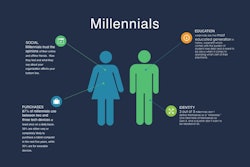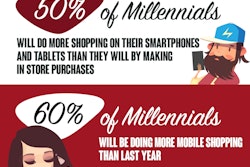
Millennials now make up the largest, most educated and diverse generation in history, and just surpassed Gen X as the largest percentage of the workforce. By 2025, approximately 75 percent of the workforce will be comprised of Millennials. The generation is now, and will continue to be, a force to reckon with in numbers alone. But what differentiates the Millennial generation from the rest of the workforce? It depends on whom you ask. There are a lot of contradicting information and opinions—even on dates, so let’s define Millennials as the generation born between the 1980s and mid-2000s. Then type “Millennials are” into Google, and you may find your impressions turn bleak when the search engine finishes your sentence with lazy, narcissistic, stupid and screwed, respectively.
What’s So Great About Millennials?
Not everyone takes such a pessimistic view of the up-and-coming generation, however. In fact, John (Buddy) W. Hobart, CEO of Solutions 21, a company that helps businesses attract and retain Millennial workers, and manage intergenerational challenges, has a habit of turning the oft-negative connotations used against Millennials into positive career skills: “People say Millennials need to be constantly reaffirmed. Well, that’s not true. They need real-time feedback.” You say narcissistic, he says goal-oriented or entrepreneurial; you say lazy, he says technologically driven.
In fact, Millennials are the first generation that can be considered technology natives, which is part of what makes them unique, according to Hobart: "Millennials have never known a world without cell phones and smartphones, and mobile technology, so they've never known a world without instantaneous information, or frankly, that 24/7/365 news cycle. From there, you can start to extrapolate what that means for their uniqueness—the instant knowledge, being able to understand what's happening in other industries and companies and locations instantly, and making instant decisions about your career or about ways to solve business issues. That simply did not exist for other generations.”
“I think they’re looking for autonomy,” asserts Cecilia Mendoza, director of marketing and public relations at the Institute for Supply Management. “I think they’re looking ways to forge their own path to get the results they’re being asked to produce. Millennials bring a different perspective and, because they are very tech-savvy, and seeking answers quickly and accessing information in real time, they will move and drive projects very fast. Organizations should definitely use that to their advantage, especially when implementing new technology, which should be led by a team of Millennials because they will have the buy-in and help with the transition period. I think that, inherently, Millennials will help drive a lot of business changes.”
“And unless you plan on going out of business in the next six months, they’re your future of work,” opines Hobart. "No one wanted to advocate for Millennials when the recession was hitting; they figured they'll fall in line like everybody else. Fast forward to 2014, and the recession, in my opinion, did not in any way break the Millennials. In fact, it emboldened them. They began to realize they can survive this, and maintain their values and drive."
And survive the recession they did, albeit not without struggle. As the 2015 Time article “Millennials Are Setting New Records—for Living with their Parents” points out, “Last year, 43 percent of young men were living at home, which is the highest rate since 1940.” This is probably when the notion that Millennials are lazy because they live in their parents’ basements was catalyzed. However, this concession was not necessarily from a generational defect. Many Millennials not only faced a tight labor market after graduation from college, but also historic student debt, which led many of them to stay in school longer to avoid the blighted job market. Now that they’re entering the slowly regenerating ranks of employment, Millennials are nothing if not hungry for a career, but they’re not always looking to do things according to tradition. The challenge, therefore, is to blend the four-generation workforce.
Technology and the Intergenerational Workforce
When working with the Millennials on her team, Mendoza prefers to focus on outcomes as opposed to enforcing standard operating procedures. Frequently, when people are hired into new positions, they receive the standard processes, procedures and manuals to follow, and are instructed on how things were done in the past. Instead, she asks, “What does success look like? If we allow Millennials to have the autonomy to create their own roadmap, success will often come quicker than how we prescribed a certain way to get there in our minds.” In fact, she says that she’s often surprised by how quickly Millennials will get to those outcomes and reach success.
Part of that success may come from the inherently tech-savvy nature of Millennials. Hobart warns, "Don't squash it!” He suggests organizations accept and capitalize on it, while also understanding that older colleagues—Gen X, Baby Boomers and Traditionalists—could misread Millennials’ connections to technology in certain situations.
If you see Millennials on smartphones during meetings, for example, it’s not correct to automatically assume they are on the devices for entertainment purposes. Millennials view mobile devices as a necessary tool to do business. Perhaps they are taking notes, or responding to a work-related alert. If the situation escalates into a distraction, then it may become necessary to intervene, and explain what they can or cannot do with their mobile devices. “If the rest of my team finds it distracting, as a leader, it's incumbent upon me to lead the team and explain to you why what you're doing is distracting to the other generations. Millennials will get it, whether they agree or disagree, they will understand and be solid followers," says Hobart.
Because of this connection to mobile technology, many companies are implementing bring-your-own-device (BYOD) policies for their staff, which means letting your employees not only bring their personal mobile devices—whether it be laptops, smartphones or tablets—to work, but also letting them install company software and applications, and access company information on them. While there are obvious security issues to work out before establishing such a policy, there are also benefits, such as attracting Millennials with flexible technology policies, the ability for employees to access work 24/7/365 from anywhere, as well as offering employees the familiarity of their own device.
Another challenge that crops up when working with Millennials is that, because they are “always” online, many work longer hours and, in some instances, expect flexibility on the part of the organization because of it. Companies are already leaning toward more flexible scheduling, but it may not always be prudent depending on the job and intergenerational sensitivities. Hobart says, “The other generations believe in their souls that presence equals work. And so, if I can’t see you, you must not be working. And that was never true. There are people who spend 12 hours in the office and get two hours’ worth of work done.” While not much can be done if a person’s presence is essential for a job function, each organization must determine if flexible scheduling could improve employee morale and retention.
“With any team, there are different personalities and work styles, and there has to be an understanding of the different work styles and personalities to make a successful team and avoid hiccups,” concurs Mendoza. The important part of integrating these four generations is hearing all of them and making informed decisions based on their symbiotic relationship. It’s not a matter of adapting your workforce to Millennials or vice versa.
"In no way do we advocate doing anything special or bending over backward for Millennials,” Hobart stresses. “We advocate doing the right things for everybody. This is the first time in history that there’s four generations in the workforce. Getting each of those generations to understand the motivators of one another—every generation thinks their way is the best way—that’s the challenge.”
Career Development Is Millennial Retention
The media exacerbates a lot of the information surrounding Millennials and their work habits, according to Hobart. "I think one of the biggest myths that Gen X and Baby Boomer managers have is that Millennials are looking for this overwhelming flexibility, almost like the job has to be at a Starbucks that has ping pong tables and pool tables. What are they really looking for? Millennials, in my opinion and in our research, are overwhelmingly willing to hook their career wagon to a strong leadership horse. By that I mean the ol' walk the walk.” Walking the walk means that, if you make a speech about how you value your employees, provide them with training. If you tell employees that they’re the company’s greatest assets, then help them navigate their prospective career roadmaps, or in Hobart’s words, “Don't tell me you care about me and have me die on the vine on this outdated career ladder.”
Hobart believes that Millennials are more interested in a career lattice than a career ladder. He laments, “The career ladder was step by step by step, and if we got stuck behind somebody, our mentors told us to just keep our noses to the grindstone and good things will happen.” In contrast, career lattices set up career development as a chess board, so pieces can move more liberally than just forward or backward (or up or down on a ladder). Millennials don’t want to spend years in a job that's not helping them grow, even if it’s not in the direction they first thought. Lateral moves don’t necessarily mean the death of a Millennial’s career as long as it’s a milestone on the journey. Regardless, navigating these moves with them and coaching them along the way bodes well in terms of retaining them. An organization must offer them the opportunity for movement if it wants them to stick around.
Forward-thinking organizations that actively recruit and retain Millennials have the option to not only intentionally develop future leaders by investing in them, but also to create a sustainable talent pool, and proactively plan for employee and leadership succession. Fortunately, the key to keeping top Millennials around is to invest in making them great leaders—through education and career development. One caveat is they don’t like to wait around to know they’re valued. Mendoza thinks organizations can show Millennials they’re valued in several ways, “whether it’s through a designated career path for growth, investment in them to obtain certification, supporting them in getting their MBA, or even attending conferences for growth and development.”
But, elaborates Hobart, “We don't have the luxury of time. A Millennial is not going to sit in a position for four years until something breaks.” He advises that, once you realize you have a Millennial with the potential to become a leader, you start developing him or her immediately. While he or she may be nowhere near ready for a supervisory or managerial role, it shows that the organization has plans for the Millennial in the future because of the value he or she brings to the table. Millennial retention can also be good for the bottom line. After all, the Forbes article “Rethinking Employee Turnover” reads, “Depending upon the complexity of the job and the level of management, the cost of turnover can equal anywhere from one month’s to several years’ salary for a departing employee.”
Mentoring is another great idea. According to Hobart, “There's so many things that experienced employees tend to take for granted, because we're what's called unconsciously competent. We don't know what we know.” Mentoring and coaching programs can offer Millennials more real-world experiences and hands-on education than setting them up with a manual and a screen. The more time Millennials spend with experienced workers and their tribal knowledge, the more they absorb, and the faster they learn and become a future leader of your organization.












